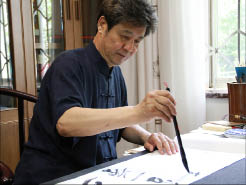| The Properties and Realms of Chinese Calligraphy
By CAI XIANGLIN

Cai Xianglin was born in Beijing in July 1952. As a renowned calligrapher and poet, he held positions in the China Calligraphers Association, such as director of its Public Relations Department, deputy director and secretary-general of its International Communication Committee, director of its exhibition center and secretary-general of its Creation Assessment Committee.
He has achieved great success in initiating and practicing a combination of the poetic and calligraphic art. Cai has been devoted to the development and academic research in contemporary calligraphy. He masterminded and organized the "World Tour of Chinese Calligraphy," a cultural event that showcases Chinese calligraphy to the world.
Cai has compiled and published a good number of books on calligraphy and poetry. His calligraphic works are collected by several museums in China and abroad. Cai has been offered part-time professorships by a number of famous universities such as China University of Political Science and Law, and Yangzhou University.
IN China, calligraphy occupies a distinguished position among traditional arts. With Chinese characters as its platform, calligraphy displays the spiritual world in an aesthetic sense. Calligraphy integrates characters with peculiar writing styles, bringing about enduring appeal of different styles with the help of the "four treasures of study" (ink, writing brush, inkstone and paper).
Having been engaged in calligraphy for decades, I have witnessed the thriving development of calligraphy in China in the last 20 years. Over the years, I served in several key positions in the China Calligraphers Association (CCA), including secretary-general of its Creation Assessment Committee and director of its exhibition center.
I often compare diverse art forms of various countries. Combining what can be learnt from calligraphy with studies of other art forms, I have come to the conclusion that there are three properties and three realms of Chinese calligraphy.
Three Properties
The first property is that Chinese calligraphy is an art of Chinese characters. The emergence, development and evolution of Chinese characters run parallel to the history of Chinese calligraphy. Our forefathers improved Chinese characters during several historical periods, forming several calligraphic styles, such as the seal character (zhuanshu), official script (lishu), regular script (kaishu), running hand (xingshu) and cursive hand (caoshu). Each style is distinguished from others by its own peculiar features and conventions.
In October 1998, the then French President Jacques Chirac visited a Chinese calligraphy exhibition held at Paris-based Sorbonne University and complimented it highly, exclaiming: "This is truly an amazing presentation!" In a congratulatory letter he wrote: "Calligraphy is an art among arts in China. Passed down through generations and centuries, it maintains its vitality by respecting traditions while encouraging innovations. Calligraphy is a national memory for all Chinese." Needless to say, this is high praise indeed.
| 